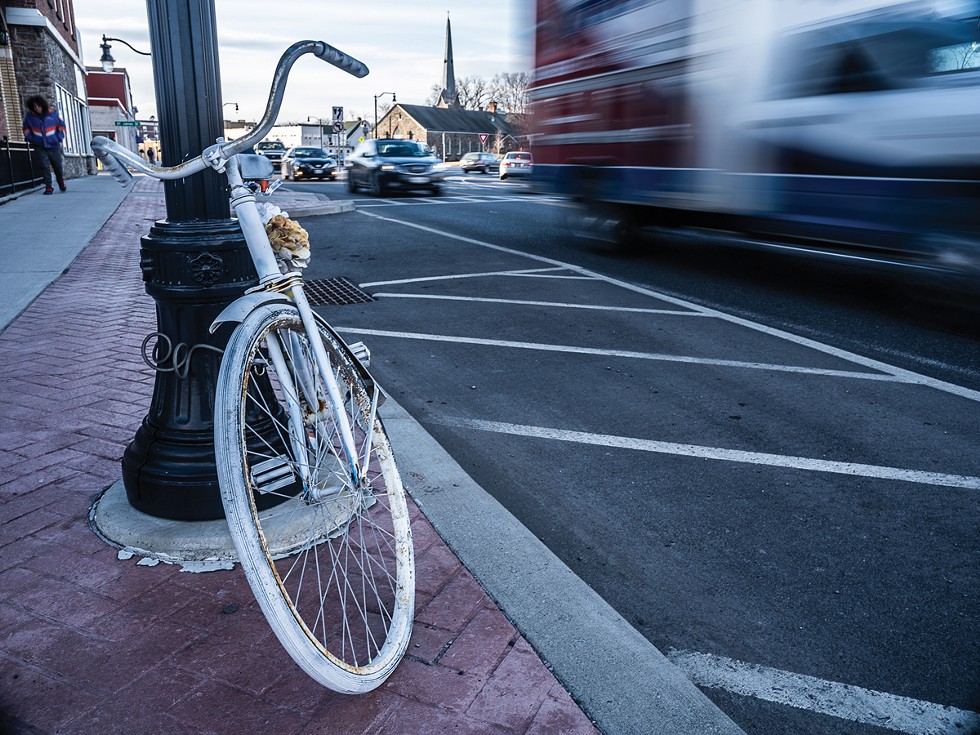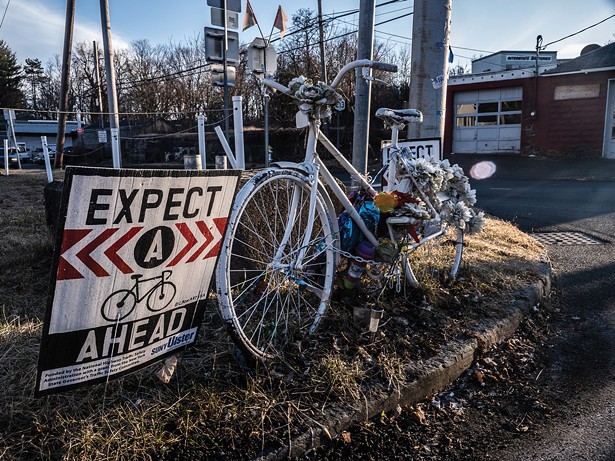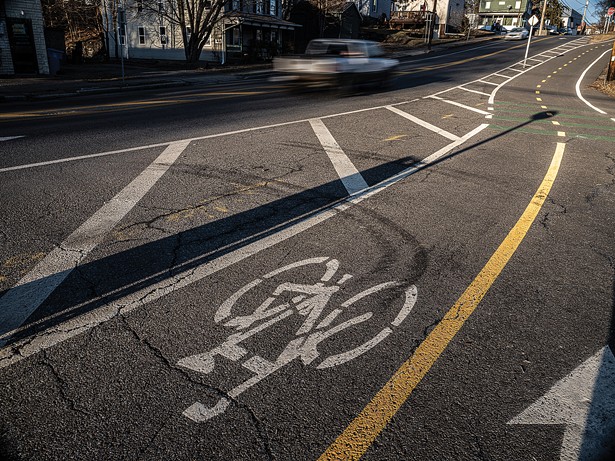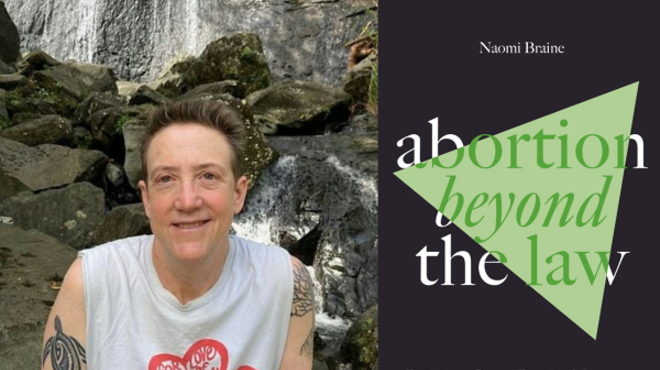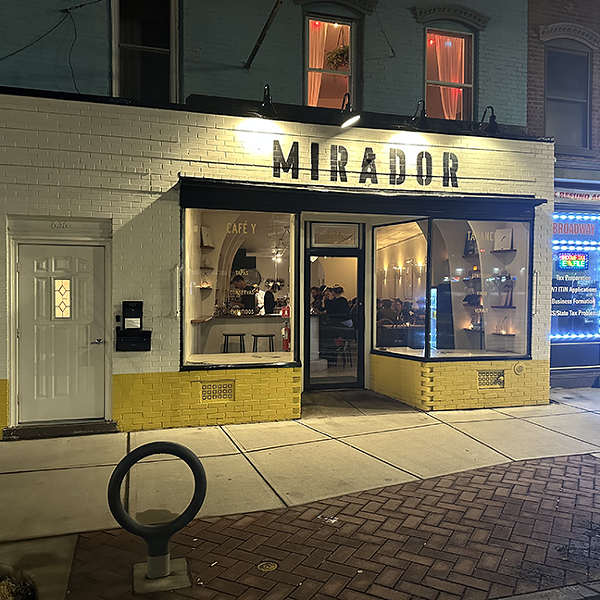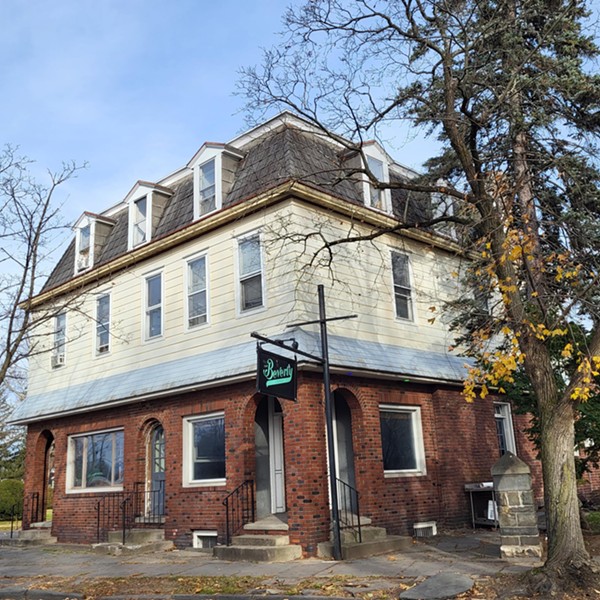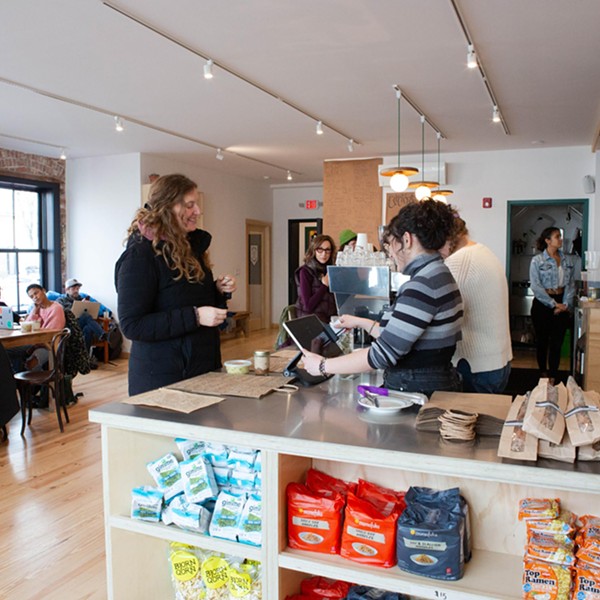There's a 10-speed bicycle painted white and chained to a road sign at the edge of Washington Avenue in Kingston, not far from the Thruway traffic circle. It's a ghost bike, memorializing where John "Host" Lynch was struck and killed by a car while riding his bicycle on July 20, 2021. The bike was placed there by Lynch's partner, Rose Quinn. Washington Avenue is a four-lane arterial roadway connecting traffic from the Thruway to the Uptown neighborhood. It's also used regularly by cyclists to connect to the O&W rail trail.
When Quinn met Lynch, she was edging closer to becoming a full-time cyclist and bike commuter. But it would be Lynch, a lifelong bike commuter himself, who introduced her to the idea of bike activism. In fact, on one of their first dates, John rode his bike from Albany to meet Quinn in Kingston so she wouldn't have to drive. John never owned a car. "John challenged me to take on bike commuting, and it has been such an eye-opening experience," says Quinn. "Invigorating and informative, but also often sad—yes, even traumatizing at times."

Earlier this year the National Highway Traffic Safety Administration released its projections for traffic fatalities in the first nine months of 2022, noting an increase in deaths among cyclists (eight percent) and pedestrians (two percent) year over year. Mirroring national and statewide trends, nonmotorized fatalities in Kingston have also increased. From 2010 to 2019, the city had zero bicycle fatalities and three pedestrian deaths. Between November 2020 and September 2021, Kingston had three bicycle fatalities even as there were fewer vehicles on the road. Most recently, in the span of two weeks in late December and early January, a cyclist and a pedestrian were both struck and killed by vehicles in separate incidents.
The night Lynch was killed, Quinn resigned from her role as a traffic safety educator and as leader of Bike-Friendly Kingston. "When John died, I had to remove myself from a lot of the work I was doing. I was disappointed. I'm still disappointed. I haven't seen the strong response that I would like to see. There's still this hesitancy to confront driving culture up here and we need to finally start thinking more about the people outside of a car who, by law, have the same rights on the road," says Quinn.
Complete Streets
Advocates believe that there is a serious disconnect between those who use the streets every day and those in positions of power. "I understand that large infrastructure projects take time and are complex, but there are other traffic-calming measures and initiatives to create safer streets and systems in Kingston. I think it really comes down to political will," says Ella Ray Kondrat, author of the Sweeten the Streets Substack focusing on transportation in Ulster County.
Kondrat recently became active in advocating for safe streets after feeling unsatisfactory results to keep vulnerable road users safe during the planning and design phases of recent improvement projects. She joined Riders for Ulster Transit Alliance and at the end of last year, she was appointed to the Complete Streets Advisory Council (CSAC). "I appreciate everything that's been done, but it's not enough," says Kondrat. "We are asking the city and county to adhere to the safe system approach on our roads."
There's no disputing that the city of Kingston has worked hard over the past 10 years to improve an antiquated system that grew dramatically to support urban sprawl and growing car culture dating back to the 1950s and maybe earlier. "There have been more infrastructure projects and improvements in the past 10 years than the 10 before that," says Brian Slack, principal transportation Planner for the Ulster County Transportation Council. "We must have a certain level of knowledge to do the job, but of equal importance is being adept at communicating these issues as well. Taking pretty complex issues and distilling them so everyone can begin to know what it means to them."
The City of Kingston adopted a Complete Streets resolution in 2010. Complete Streets policies help guide towns and cities in planning, designing, and improving streets for the safety of all road users. Over the past 10 years, Kingston has seen a transformation of much of its streetscapes thanks to these policies and the work of the city to move toward a more climate-resilient community. The CSAC advises the city, makes recommendations, and gives feedback on forthcoming infrastructure projects. Importantly, the council advised the city to adopt a set of guidelines that further allow the city autonomy in creating safe systems for all users. Complete streets policies align with the broader "Vision Zero" goal that was recently made a priority by Secretary of Transportation Pete Buttigieg.
Connection, Direction
The reconstruction of Broadway is a model example of a Complete Street, according to Slack. "Separating the biker is the ultimate goal. There's a two-way cycle track, something the cycling community really wanted, we've moved four lanes to three—a road diet, created floating parking separating the bikers from the motor vehicles, and intersections with rectangular rapid flashing beacons to further the safety of those using the crosswalk," says Slack.
Those in the cycling community, including Quinn, applaud the city and county for taking these steps forward and consider these actions well-intentioned but intentions don't save lives. She says that there is still a prioritization of traffic flows and congestion. "Most of Broadway still has no cycling infrastructure and the lack of obvious connection or direction on either end of Broadway when the tracks stop makes for an incredibly unsafe situation," says Quinn.
Quinn, a Queens native, hadn't grown up car-dependent and made the conscious decision to move to Kingston from New Paltz in 2012 specifically for the ability to walk or bike to get around. The Kington Greenline, a largely complete nonmotorized transportation plan to connect the regional and city trails, old trolley corridors, and other pedestrian and cyclist infrastructure is a good example. Aside from pure recreation, parts of it, including Linear Park, have helped to open access to a community that previously had little to no access prior to its construction—a food desert. According to the most recent US Census, 17.4 percent of households in Kingston have no car.
"These are beautiful examples of what urban travel can be. It's a really good start" says Quinn. "But cyclists and pedestrians must have safe options to access the trail systems. If you don't have a car to get to the trails, there must be safe routes and alternatives for connection." The night Lynch was killed he was out for a recreational ride. Although he a was bike commuter and road rider, that evening, he was mostly on trails and was navigating the Washington Avenue crossing on his way home.
Greenkill Avenue is one of many important multi-use roadways that helps connect those coming in and out of Kingston on Route 32. It's used by the cycling community as a cut-through across town and is also part of the Empire State Trail, an initiative set forth by then-Governor Cuomo that was finished in 2020. Only two months later, Darryl Savage, 54, was killed by a bus while using the newly constructed project. Savage, a Kingston resident and longtime neighborhood rider, was using the new infrastructure and may have been confused by the updated traffic signals, according to Quinn. "The project was fast-tracked and the Governor made this project a huge priority," says Slack. Since then, New York State removed the signal in question on Greenkill Avenue and replaced it with a stop sign. Lynch and Quinn helped to plan a memorial for Savage.
"There has been such a huge change to our infrastructure in such a short amount of time that road users are unclear of where they belong," says Slack. "These are new and evolving approaches to transportation and people need to know how to use them." Community education and involvement, according to all stakeholders, are both areas of improvement in the city of Kingston and the county.
Continuing Education
The YMCA of Kingston and Ulster County is one organization that continues to promote traffic safety education. For the last 12 years, Tom Polk, a Kingston resident and bicycle educator and safety coordinator for the YMCA, has worked tirelessly to make bike education and safety a reality. Programs like Bike It, where middle school-aged children learn bike safety, bike maintenance, and ride through the city, all support youth education. Importantly, Polk also runs the Lend-a-Wheel bicycle reuse program which rehabs donated bicycles and offers them free of charge to people in need of basic transport—1,122 bicycles have been distributed to date. (Lynch worked for Polk as a paid mechanic and Quinn still helps regularly.) Polk sits on the Ulster County Traffic Safety Board (UCTSB), with Quinn, Slack, and other city officials to help advocate for the safety of all road users. The YMCA is also near the intersection where Christine "Rena" Tarasco, 65, was struck and killed by a motor vehicle on her way home from a doctor's appointment on December 27, 2022 while riding her bicycle.
One forthcoming initiative is called the Friendly Driver Initiative, a driver-awareness-and-safety program for commercial and bus drivers holding a commercial driver's license (CDL). Polk acknowledges that these drivers already get a lot of training focusing on vehicles throughout the county. "This program focuses on the people who are not in vehicles," he says. "The walkers and the bikers and how drivers need to be aware of their behavior and the laws for all road users." The importance of this initiative weighs heavy in the city of Kingston since two of the five recent fatalities involved drivers holding a CDL. Sarah Edwards, 59, was struck and killed by a school bus crossing the street on January 6.
Polk says that he's frequently asked what to do about the cyclists who are riding the wrong way, not wearing helmets, and not stopping at stop signs. "'They ought to learn the rules of the road,' people say to me, and I agree, but I can't force them to take a class. The flip side of that is what about the person in the car who is running the stop sign, not slowing down, texting while driving—what about them?"
Polk acknowledges the recent traffic safety awareness campaign efforts the city of Kingston has made, one of which is the Be a Road Hero campaign. The goal of this citywide initiative is to educate locals and tourists about the recent improvements and additions to the infrastructure with a focus on the new Broadway infrastructure. There are also many drivers new to the area since the pandemic who need to learn as well, according to Polk. The campaign includes videos, bus ads, social media, mailers, and help from local law enforcement to educate all road users.
Rather than issuing citations for a first offense, Kingston Police Chief Egidio Tinti and his officers use warnings to educate before issuing citations to encourage safe road habits. "We are driven by community policing. We recognize that every encounter is a chance to educate the public. We want to be a part of the Kingston community," says Chief Tinti. "These public education campaigns are absolutely worthwhile." The Be a Road Hero campaign will continue into this year.
This type of action is something advocates acknowledge as an important step, and point out that it should have happened long before the completion of these systems. "If you don't do those things, a community feels as though it is under siege when these projects happen and important changes to address critical adjustments to evolving infrastructure are lost, and sometimes lives are as well," says Quinn. It's worth noting that this city-funded safety campaign initially was voted down by the majority of Common Council members. It wasn't until after the death of Devin Griffiths on September 18, 2021, who was struck by a tractor-trailer near East St. James Street and Broadway, and a request from Mayor Steve Noble that program was reconsidered.
Since the pandemic aggressive driving has also increased. "As a motor vehicle operator, I feel more in danger. When I'm driving and see people running red lights, there's a crash waiting to happen," says Polk. And although Chief Tinti was hesitant to point to one cause, Saugerties Chief of Police Joseph Sinagra, a Kingston resident, is more inclined to highlight driver behavior. "The biggest problem we have since the pandemic is aggressive driving. We backed off on traffic enforcement during the pandemic and that gave drivers free reign."
Both Slack and Planning Director Dennis Doyle point toward increasing highly visible enforcement as a possible solution. "Whenever a major holiday rolls around, the messaging surrounding drinking and driving increases and it works. A lot of people get pulled over. A lot of people are doing it," says Slack. The Governor's Traffic Safety Guidelines even list it as a top solution. And although Quinn agrees that, in theory, visible enforcement is effective, that won't be the answer. "Sure, whenever there's a cop on the interstate or road you slow down. But it's not sustainable." Perhaps she's right. Currently, the Kingston Police department is down five officers from regular staffing levels. "We are on board but we don't have the manpower right now," says Chief Tinti.
Preventable Tragedies
In August, Governor Hochul signed into law parts of the Crash Victims Rights and Safety Act. Among those is legislation that will require new drivers to learn about pedestrian and bicycle safety as a part of the learner's permit education and exam in New York. Quinn would like there to be a shift in how we approach traffic safety education overall, shifting our mindset and returning the responsibility back onto the driver. "Traffic education needs to be taught starting in elementary school and continuing the rest of our lives," says Quinn. Right now, once drivers meet the driving standards in the state of New York and pass the driver's license test and requirements, there is no continuing education for drivers unless deemed necessary based on driving records. "Think about it: How many years you've been driving. Have you ever had to be tested again? Once you pass the test, that's it!" says Chief Tinti, acknowledging that more can be done in terms of driver education.
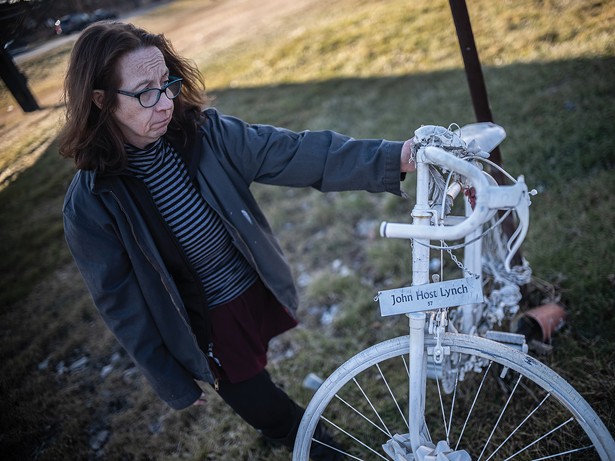
Another new piece of state legislation passed last year will allow municipalities the ability to lower speed limits to 25 mph. Prior to this new law, speed limits could not go below 30 mph except in school zones and in special circumstances. Now municipalities will have the ability to lower speed limits, though it will still take time for locals to see those changes.
Importantly, the city of Kingston has been working on a Bicycle and Pedestrian Master Plan since 2020. "We collected information about the existing infrastructure for walkers and bikers in Kingston. This is a planning document and will serve as a guide to inform the existing and planned pedestrian and bicycle network and will identify any gaps in those systems," says Emily Flynn, director of health and wellness for Kingston and project manager for the plan. Currently, the plan is in draft form and will be made public in the spring of this year. "The goal of my job is to get more people walking, biking, and using other forms of active transportation," says Flynn.
"These tragedies are preventable," say Quinn, "and creating safe streets benefits everyone." Now Kondrat and Quinn are working to form a new advocacy group that will focus on education and ensuring safe systems and streets in Kingston and Ulster County. At the end of the day, cycling advocates want drivers to bring their humanity behind the wheel. "That's all I'm asking. When you get in a car and before turning on the ignition, take a minute and understand the real position of privilege you have—in every way. Understand that you have the ability to take your own life. You have the ability to take the lives of others," says Quinn.







